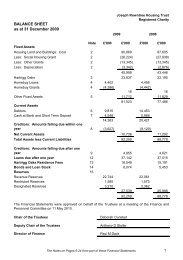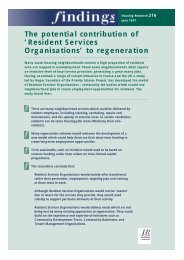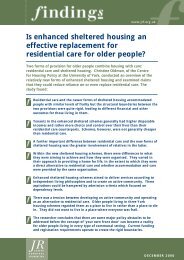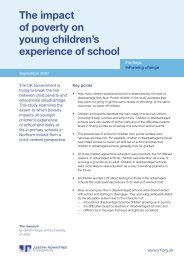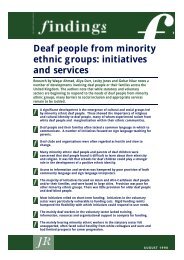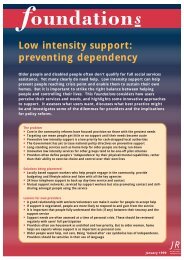Community participation - Joseph Rowntree Foundation
Community participation - Joseph Rowntree Foundation
Community participation - Joseph Rowntree Foundation
Create successful ePaper yourself
Turn your PDF publications into a flip-book with our unique Google optimized e-Paper software.
Executive summary<br />
What the literature says<br />
Many academic studies have confirmed that the way governance works helps to<br />
create social capital. Involving people in governance is one way to do this, because it<br />
helps to build ‘linking’ social capital.<br />
However, social capital is a bit like legal tender – it is valuable to some people at<br />
some times and places, and not at all valuable in others. For linking social capital to<br />
be valuable, it really needs to be combined with other kinds of social capital in the<br />
right way.<br />
That’s because there is no reason to suppose that linking social capital will be<br />
‘distributed evenly or brokered fairly’. It is more likely to be embodied in key<br />
relationships between particular individuals or organisations – for example, between<br />
the chair of a residents’ association and the housing professionals in the local<br />
authority.<br />
Access to linking social capital is shaped by a range of background factors that affect<br />
levels of <strong>participation</strong>, including socio-economic status, geographical circumstances,<br />
ethnicity, age and gender. Fewer women, for instance, tend to be involved in formal<br />
governance roles than men.<br />
The research also shows that governance arrangements are not neutral. The way<br />
that they are designed can intensify or mitigate the impact of these factors. A very<br />
simple example is that the timing and location of meetings can affect whether those<br />
with childcare responsibilities can participate.<br />
What our research says<br />
Our research found that the key factor influencing levels of <strong>participation</strong> in<br />
governance was the existing pattern of linking social capital – those already well<br />
connected tend to get better connected. We found that relatively few people were<br />
involved in governance, and the few people involved in one setting tended to be the<br />
same few people in another setting – the school governor also sat on the patients’<br />
panel as well as being a board member of the regeneration partnership.<br />
Our research also suggests that the way governance arrangements work makes this<br />
problem worse. Its origins lay at the level of the system as a whole, not in the bad<br />
practices of particular institutions. In particular, a number of forces create ‘barriers to<br />
ix




